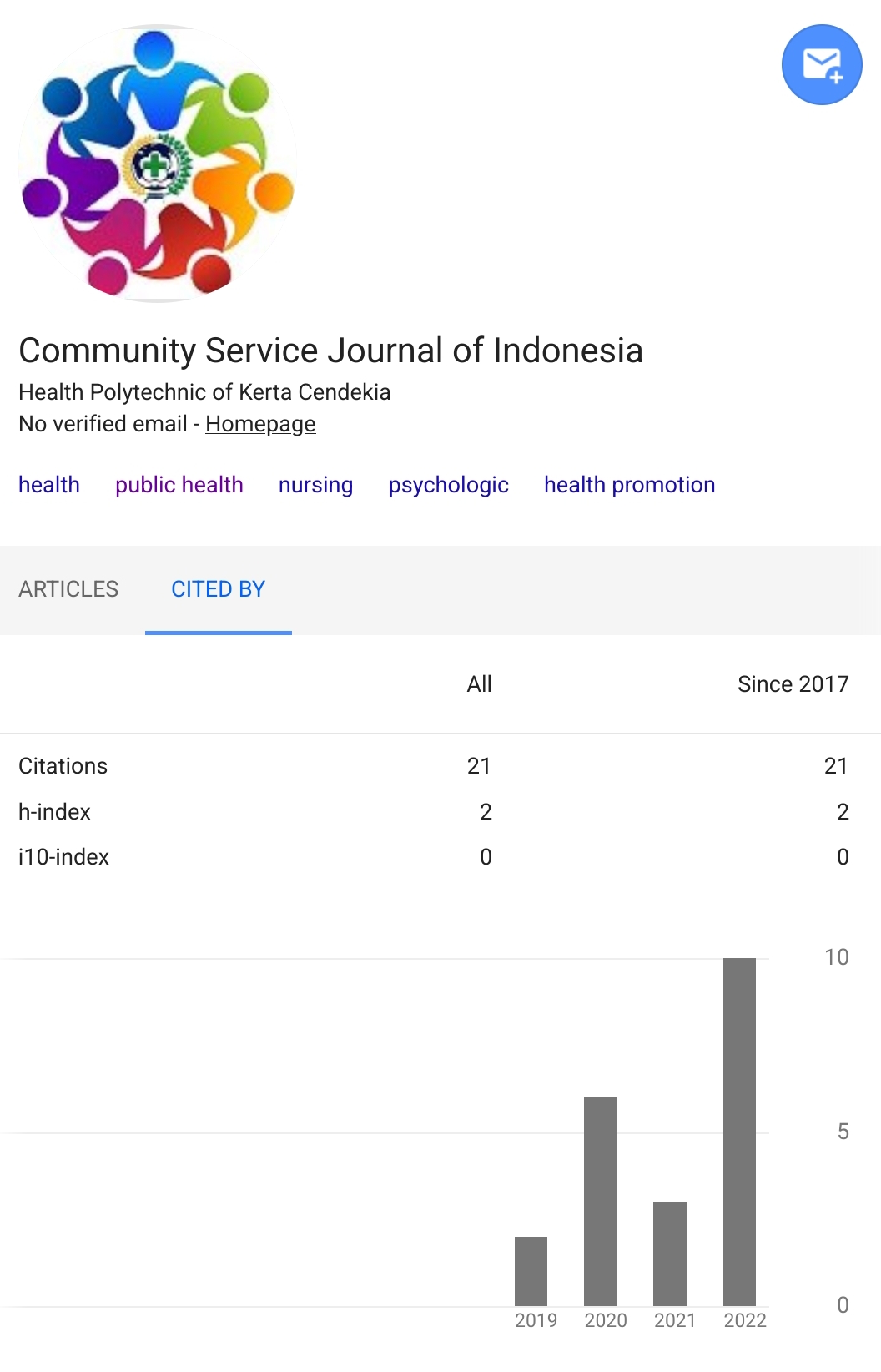BOBATH THERAPY AS AN EARLY STROKE PREVENTION EFFORT
Abstract
In ischemic stroke patients, the main problem that occurs is cerebral blood flow disturbances. Global Burden Disease data shows that 80% of the population is ischemic stroke and 20% hemorrhagic stroke with a moderate level of neurological deficit of 89%. Nursing actions that can be taken are by providing activities to stroke patients to increase cerebral blood flow. The implementation of this community service activity aims to teach Cadres and the community regarding Bobath Therapy as an early stroke prevention effort. The method used in this community service activity is to provide training and education health services. This activity was carried out during April-May 2022 which was attended by 12 health cadres and 22 residents in RW 06 Wonokromo Village, Surabaya. The results show that the activity has achieved success according to the success indicators that have been set, namely as many as 12 health cadres were successfully recruited; average attendance is 100%, participants participate in activities enthusiastically, knowledge of cadres after training and residents after counseling increases significantlyReferences
Aksoy, G., & Timurtas, E. (2015). The Effectiveness of Bobath Treatment Approach in Physiotherapy of Case with Ehlers-Danlos Syndrome. Journal of Arthritis, 05(01), 1–4. https://doi.org/10.4172/2167-7921.1000191 DOI: https://doi.org/10.4172/2167-7921.1000191
Brandes, M. S., & Gray, N. E. (2020). NRF2 as a Therapeutic Target in Neurodegenerative Diseases. ASN Neuro, 12. https://doi.org/10.1177/1759091419899782 DOI: https://doi.org/10.1177/1759091419899782
Center for Disease Control and Prevention. (2019). Stroke Facts.
Dancer, S., Brown, A. J., & Yanase, L. R. (2017). National Institutes of Health Stroke Scale in Plain English Is Reliable for Novice Nurse Users with Minimal Training. Journal of Emergency Nursing, 43(3), 221–227. https://doi.org/10.1016/j.jen.2016.09.002 DOI: https://doi.org/10.1016/j.jen.2016.09.002
Demortier, M., & Leboeuf-Yde, C. (2020). Unravelling Functional Neurology: An overview of all published documents by FR Carrick, including a critical review of research articles on its effect or benefit. Chiropractic and Manual Therapies, 28(1), 1–17. https://doi.org/10.1186/s12998-019-0287-2 DOI: https://doi.org/10.1186/s12998-019-0287-2
Dunsky, A., Zeev, A., & Netz, Y. (2017). Balance Performance Is Task Specific in Older Adults. BioMed Research International, 2017, 0–6. https://doi.org/10.1155/2017/6987017 DOI: https://doi.org/10.1155/2017/6987017
Gilmour, G. S., Nielsen, G., Teodoro, T., Yogarajah, M., Coebergh, J. A., Dilley, M. D., Martino, D., & Edwards, M. J. (2020). Management of functional neurological disorder. Journal of Neurology, 267(7), 2164–2172. https://doi.org/10.1007/s00415-020-09772-w DOI: https://doi.org/10.1007/s00415-020-09772-w
Gray, C., & Ford, C. (2018). Bobath Therapy for Patients with Neurological Conditions: A Review of Clinical Effectiveness, Cost-Effectiveness, and Guidelines. Bobath Therapy for Patients with Neurological Conditions: A Review of Clinical Effectiveness, Cost-Effectiveness, and Guidelines, 1–26.
Kementrian Kesehatan Republik Indonesia. (2019). Laporan Hasil Riset Kesehatan Dasar 2018.
Mikołajewska, E. (2017). Bobath and traditional approaches in post-stroke gait rehabilitation in adults. Biomedical Human Kinetics, 9(1), 27–33. https://doi.org/10.1515/bhk-2017-0005 DOI: https://doi.org/10.1515/bhk-2017-0005
Notoatmodjo, S. (2012). Promosi Kesehatan Dan Perilaku Kesehatan. Rineka Cipta.
Pumprasart, T., Pramodhyakul, N., & Piriyaprasarth, P. (2019). The effect of the Bobath therapy programme on upper limb and hand function in chronic stroke individuals with moderate to severe deficits. International Journal of Therapy and Rehabilitation, 26(10). https://doi.org/10.12968/ijtr.2018.0124 DOI: https://doi.org/10.12968/ijtr.2018.0124
Schwartzman, R. J. (2019). Differential Diagnosis in Neurology: Revised Second Edition. IOS Pres. https://doi.org/10.3233/BHR78
Smeltzer, S. C., & Bare, B. G. (2013). Keperawatan Medikal Bedah Brunner & Suddart Edisi 12. EGC.
Sukrayasa, W., Martiningsih, E., & Agung, I. G. A. A. (2018). “Strategi Pemberdayaan Kader Posyandu untuk Meningkatkan Program Gizi di Kecamatan Denpasar Utara.” Jurnal Ilmu Gizi: Journal of Nutrition Science, 7(2), 42–48.
Copyright (c) 2022 Imamatul Faizah, Niken Adiba Nadya, Dyah Yuniati, Ratna Yunita Sari, Yanis Kartini, Abdul Muhith, Riska Rohmawati

This work is licensed under a Creative Commons Attribution-NonCommercial 4.0 International License.
Authors who publish with Community Service Journal of Indonesia agree to the following terms:
- Authors retain copyright licensed under a Creative Commons Attribution-NonCommercial 4.0 (CC BY-NC 4.0), which allows others to remix, tweak, and build upon the authors' work non-commercially, and although the others' new works must also acknowledge the authors and be non-commercial, they don't have to license their derivative works on the same terms.
- Authors are permitted and encouraged to post their work online (e.g., in institutional repositories or on their website) prior to and during the submission process, as it can lead to productive exchanges, as well as earlier and greater citation of published work (See The Effect of Open Access). Authors can archive pre-print and post-print or publisher's version/PDF.













